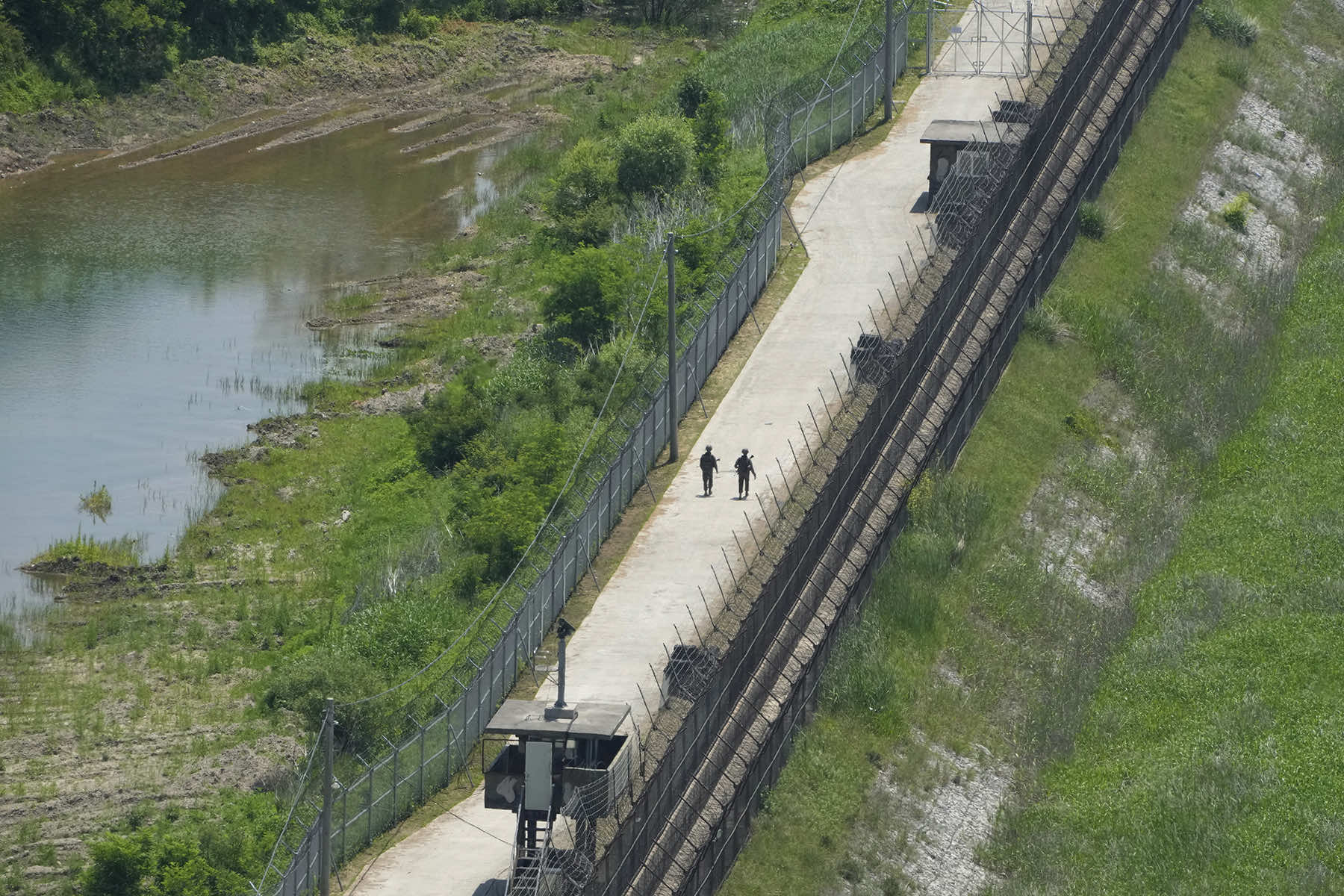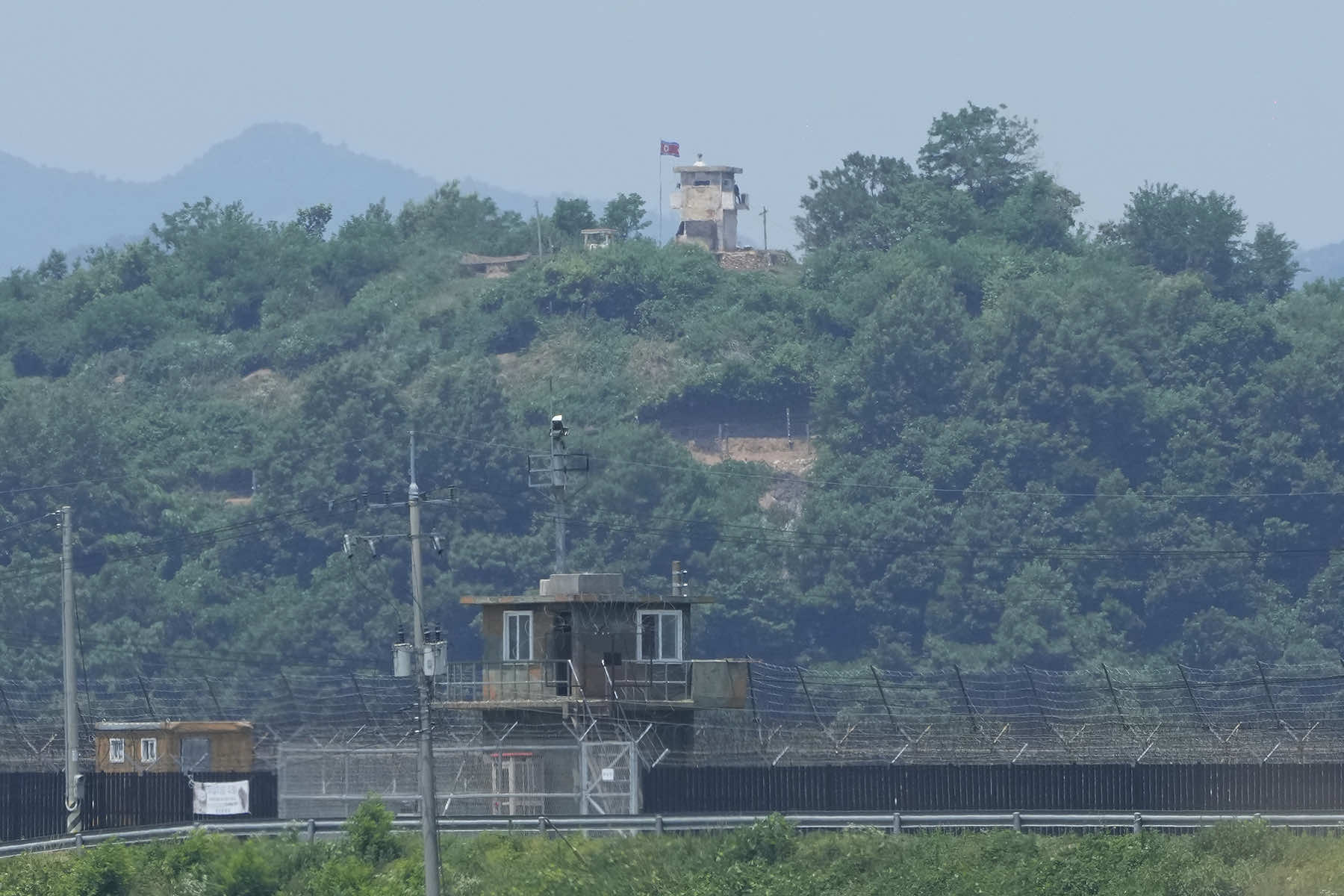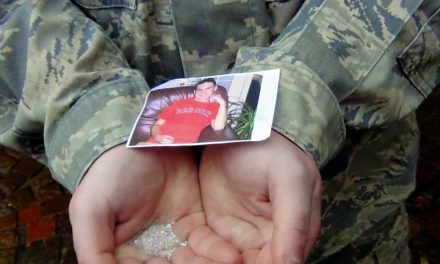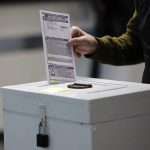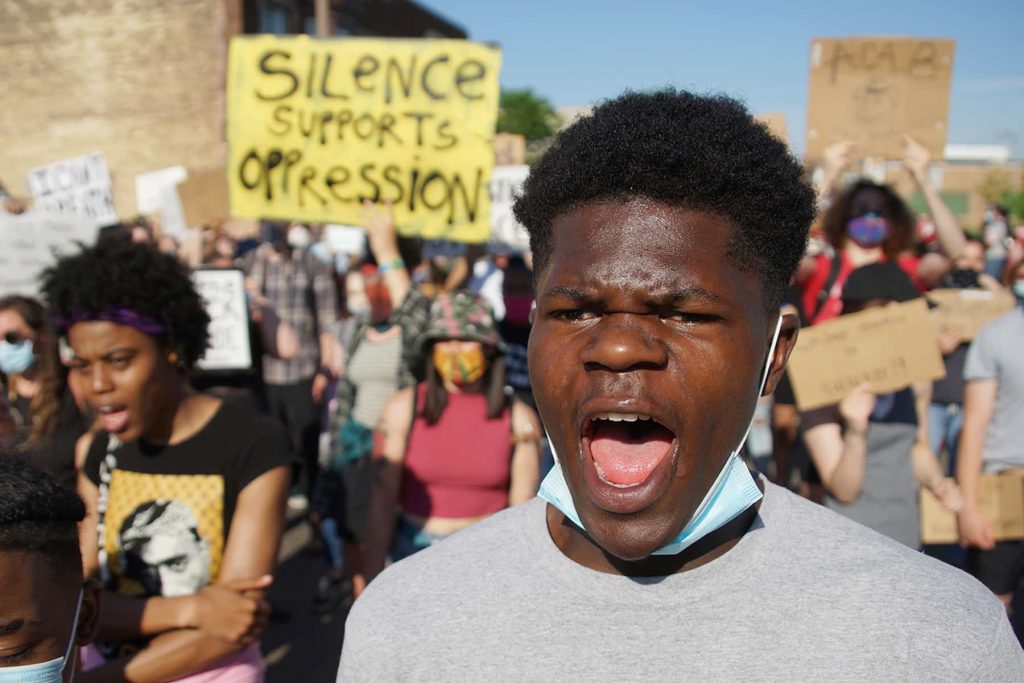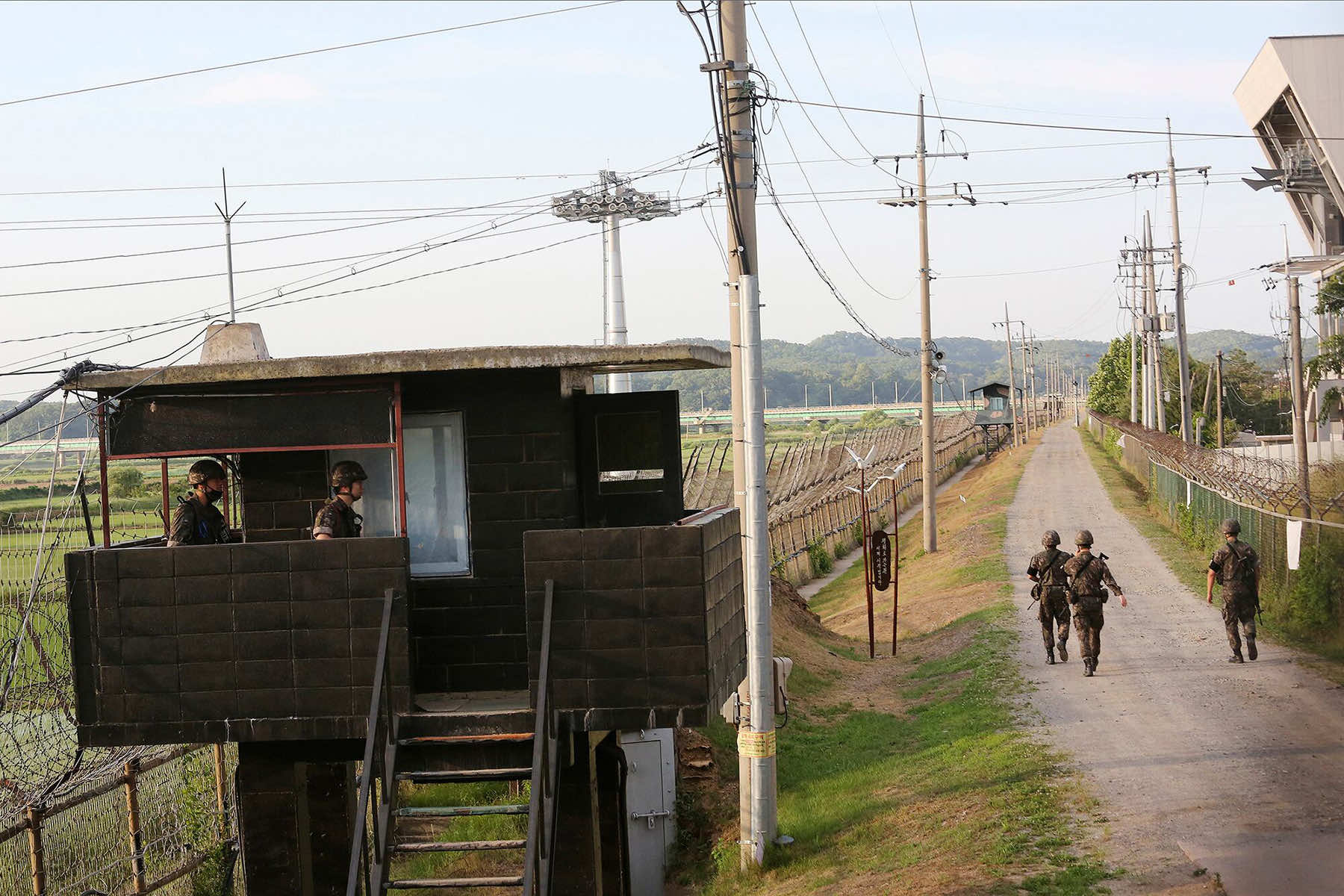
The Demilitarized Zone (DMZ) between North and South Korea is arguably one of the most misnamed regions in the world, considering it is one of the most heavily fortified and militarized areas on the planet.
Spanning 154 miles long and 2.5 miles wide, the DMZ is lined with two million land mines, barbed wire fences, tank traps, and tens of thousands of troops from both sides.
In recent months, South Korea has reported multiple incidents involving North Korean soldiers crossing the land border. South Korea’s Joint Chiefs of Staff attributed the incursions to overgrown foliage that obscured the signs marking the thin military demarcation line. Despite being deemed accidental, these incursions highlight the fragile and volatile state of the border region.
On one occasion over the summer, about 20 to 30 North Korean soldiers crossed the demarcation line due to overgrown foliage obscuring the border markers. South Korean troops responded with warning shots, and the North Koreans retreated.
“Our alliance is the greatest in the world and capable of defeating any enemy,” said South Korean President Yoon Suk Yeol emphasized.
Yoon became the first sitting South Korean president since 1994 to board a U.S. aircraft carrier, highlighting the interwoven military cooperation between the two nations.
South Korea has been preparing to deploy anti-air laser weapons systems called “Block-I” to intercept North Korean drones. Developed by Hanwha Aerospace, the system is capable of launching precision attacks on small incoming drones and multi-copters. Successful tests have proven its credibility, yet some experts doubt its effectiveness due to South Korea’s less advanced anti-air radar systems.
“We face North Korea on our doorstep, and its drones pose present threats to us, so that’s why we’ve been aiming to build and deploy laser weapons soon to cope with them,” said a South Korean military official.
The situation at the border has seen waves of escalation from North Korea, when it resumed its trash-carrying balloon launches. The balloons, often filled with waste paper, cigarette butts, and even manure, have been floated across the border in response to leafleting campaigns by South Korean activists.
In retaliation to the trash balloons, South Korea restarted anti-Pyongyang propaganda broadcasts using front-line loudspeakers, a tactic reminiscent of Cold War-era psychological warfare. The broadcasts included K-pop songs, weather forecasts, and news, which North Korea views as a direct threat to its political system and leadership.
Kim Yo Jong, the powerful sister of North Korean leader Kim Jong Un, has been particularly vocal about these tensions. She warned that South Korean “scum” must be ready to pay “a gruesome and dear price” for their leafleting activities. The rhetoric has raised concerns about potential physical provocations from North Korea, such as floating explosive mines downriver.
South Korea has acknowledged the threat, noting that North Korean land mines could be swept into South Korea by flooding, potentially causing deadly incidents.
Along with its brinksmanship, North Korea has been fortifying its side of the border. Construction efforts, which began in April, include adding anti-tank barriers, reinforcing roads, and planting tens of thousands of additional mines.
The measures aim to boost frontline security and prevent defections from North Korea to South Korea. According to reports, North Korean military personnel have suffered casualties from mine explosions and heat exposure, either by accident on patrols or in efforts to escape the repressive regime.
In response to North Korea’s balloon campaigns, South Korea suspended a 2018 tension-reduction deal, a step required to restart propaganda broadcasts and conduct live-fire military drills at border areas. In June, South Korea made propaganda broadcasts for about two hours but did not continue, until weeks later after North Korea’s balloon launches.
South Korea warned that it would conduct loudspeaker broadcasts in a fuller manner, and take other stronger steps if North Korea continued provocations. The volatile dynamics along the DMZ are not new. The border has a long, often violent history since the Korean War ended with an armistice rather than a peace treaty, leaving the peninsula technically still in a state of war.
The DMZ has seen a range of incidents, from accidental incursions to direct confrontations. For instance, in 2015, North Korea’s wooden mine boxes washed downriver during summer, causing deadly incidents in South Korea.
The psychological warfare between the two Koreas has intensified in recent months, with both sides using different platforms to convey their messages. It is estimated that North Korea has launched more than 2,000 balloons since late May.
In contrast, South Korea’s propaganda broadcasts aim to demoralize North Korean troops and residents, posing a blow to Kim Jong Un’s authoritarian rule. These broadcasts, combined with live-fire military drills at border areas, signal a significant escalation in the tit-for-tat cycle of provocations.
South Korea has also boosted its military readiness to prepare for further North Korean provocations. The deployment of the USS Theodore Roosevelt carrier and its strike group in June to South Korea was part of a 2023 deal aimed at enhancing the visibility of U.S. strategic assets on the Korean Peninsula. The deployment was intended to cope with North Korea’s nuclear threats and its advancing military partnerships with Russia.
MI Staff (Korea), with Kim Tong-Hyung
Ahn Young-joon (AP), Kim Hong-Ji (AP), and Lee Jin-man (AP)
- Exploring Korea: Stories from Milwaukee to the DMZ and across a divided peninsula
- A pawn of history: How the Great Power struggle to control Korea set the stage for its civil war
- Names for Korea: The evolution of English words used for its identity from Gojoseon to Daehan Minguk
- SeonJoo So Oh: Living her dream of creating a "folded paper" bridge between Milwaukee and Korean culture
- A Cultural Bridge: Why Milwaukee needs to invest in a Museum that celebrates Korean art and history
- Korean diplomat joins Milwaukee's Korean American community in celebration of 79th Liberation Day
- John T. Chisholm: Standing guard along the volatile Korean DMZ at the end of the Cold War
- Most Dangerous Game: The golf course where U.S. soldiers play surrounded by North Korean snipers
- Triumph and Tragedy: How the 1988 Seoul Olympics became a battleground for Cold War politics
- Dan Odya: The challenges of serving at the Korean Demilitarized Zone during the Vietnam War
- The Korean Demilitarized Zone: A border between peace and war that also cuts across hearts and history
- The Korean DMZ Conflict: A forgotten "Second Chapter" of America's "Forgotten War"
- Dick Cavalco: A life shaped by service but also silence for 65 years about the Korean War
- Overshadowed by conflict: Why the Korean War still struggles for recognition and remembrance
- Wisconsin's Korean War Memorial stands as a timeless tribute to a generation of "forgotten" veterans
- Glenn Dohrmann: The extraordinary journey from an orphaned farm boy to a highly decorated hero
- The fight for Hill 266: Glenn Dohrmann recalls one of the Korean War's most fierce battles
- Frozen in time: Rare photos from a side of the Korean War that most families in Milwaukee never saw
- Jessica Boling: The emotional journey from an American adoption to reclaiming her Korean identity
- A deportation story: When South Korea was forced to confront its adoption industry's history of abuse
- South Korea faces severe population decline amid growing burdens on marriage and parenthood
- Emma Daisy Gertel: Why finding comfort with the "in-between space" as a Korean adoptee is a superpower
- The Soul of Seoul: A photographic look at the dynamic streets and urban layers of a megacity
- The Creation of Hangul: A linguistic masterpiece designed by King Sejong to increase Korean literacy
- Rick Wood: Veteran Milwaukee photojournalist reflects on his rare trip to reclusive North Korea
- Dynastic Rule: Personality cult of Kim Jong Un expands as North Koreans wear his pins to show total loyalty
- South Korea formalizes nuclear deterrent strategy with U.S. as North Korea aims to boost atomic arsenal
- Tea with Jin: A rare conversation with a North Korean defector living a happier life in Seoul
- Journalism and Statecraft: Why it is complicated for foreign press to interview a North Korean defector
- Inside North Korea’s Isolation: A decade of images show rare views of life around Pyongyang
- Karyn Althoff Roelke: How Honor Flights remind Korean War veterans that they are not forgotten
- Letters from North Korea: How Milwaukee County Historical Society preserves stories from war veterans
- A Cold War Secret: Graves discovered of Russian pilots who flew MiG jets for North Korea during Korean War
- Heechang Kang: How a Korean American pastor balances tradition and integration at church
- Faith and Heritage: A Pew Research Center's perspective on Korean American Christians in Milwaukee
- Landmark legal verdict by South Korea's top court opens the door to some rights for same-sex couples
- Kenny Yoo: How the adversities of dyslexia and the war in Afghanistan fueled his success as a photojournalist
- Walking between two worlds: The complex dynamics of code-switching among Korean Americans
- A look back at Kamala Harris in South Korea as U.S. looks ahead to more provocations by North Korea
- Jason S. Yi: Feeling at peace with the duality of being both an American and a Korean in Milwaukee
- The Zainichi experience: Second season of “Pachinko” examines the hardships of ethnic Koreans in Japan
- Shadows of History: South Korea's lingering struggle for justice over "Comfort Women"
- Christopher Michael Doll: An unexpected life in South Korea and its cross-cultural intersections
- Korea in 1895: How UW-Milwaukee's AGSL protects the historic treasures of Kim Jeong-ho and George C. Foulk
- "Ink. Brush. Paper." Exhibit: Korean Sumukhwa art highlights women’s empowerment in Milwaukee
- Christopher Wing: The cultural bonds between Milwaukee and Changwon built by brewing beer
- Halloween Crowd Crush: A solemn remembrance of the Itaewon tragedy after two years of mourning
- Forgotten Victims: How panic and paranoia led to a massacre of refugees at the No Gun Ri Bridge
- Kyoung Ae Cho: How embracing Korean heritage and uniting cultures started with her own name
- Complexities of Identity: When being from North Korea does not mean being North Korean
- A fragile peace: Tensions simmer at DMZ as North Korean soldiers cross into the South multiple times
- Byung-Il Choi: A lifelong dedication to medicine began with the kindness of U.S. soldiers to a child of war
- Restoring Harmony: South Korea's long search to reclaim its identity from Japanese occupation
- Sado gold mine gains UNESCO status after Tokyo pledges to exhibit WWII trauma of Korean laborers
- The Heartbeat of K-Pop: How Tina Melk's passion for Korean music inspired a utopia for others to share
- K-pop Revolution: The Korean cultural phenomenon that captivated a growing audience in Milwaukee
- Artifacts from BTS and LE SSERAFIM featured at Grammy Museum exhibit put K-pop fashion in the spotlight
- Hyunjoo Han: The unconventional path from a Korean village to Milwaukee’s multicultural landscape
- The Battle of Restraint: How nuclear weapons almost redefined warfare on the Korean peninsula
- Rejection of peace: Why North Korea's increasing hostility to the South was inevitable
- WonWoo Chung: Navigating life, faith, and identity between cultures in Milwaukee and Seoul
- Korean Landmarks: A visual tour of heritage sites from the Silla and Joseon Dynasties
- South Korea’s Digital Nomad Visa offers a global gateway for Milwaukee’s young professionals
- Forgotten Gando: Why the autonomous Korean territory within China remains a footnote in history
- A game of maps: How China prepared to steal Korean history to prevent reunification
- From Taiwan to Korea: When Mao Zedong shifted China’s priority amid Soviet and American pressures
- Hoyoon Min: Putting his future on hold in Milwaukee to serve in his homeland's military
- A long journey home: Robert P. Raess laid to rest in Wisconsin after being MIA in Korean War for 70 years
- Existential threats: A cost of living in Seoul comes with being in range of North Korea's artillery
- Jinseon Kim: A Seoulite's creative adventure recording the city’s legacy and allure through art
- A subway journey: Exploring Euljiro in illustrations and by foot on Line 2 with artist Jinseon Kim
- Seoul Searching: Revisiting the first film to explore the experiences of Korean adoptees and diaspora





